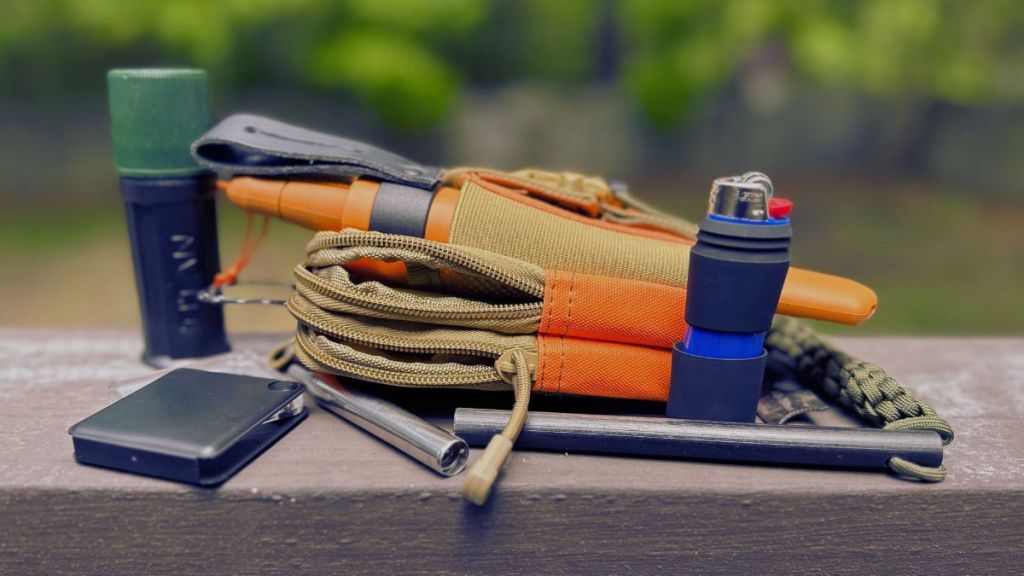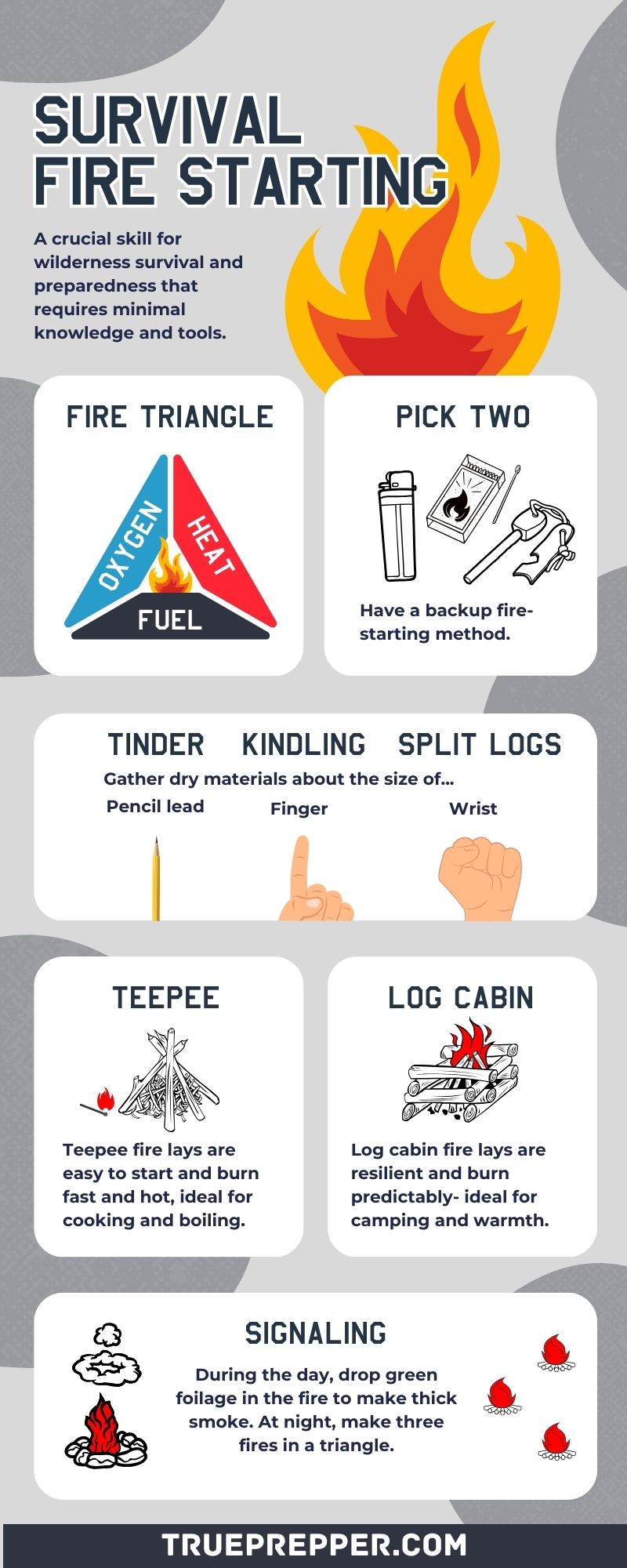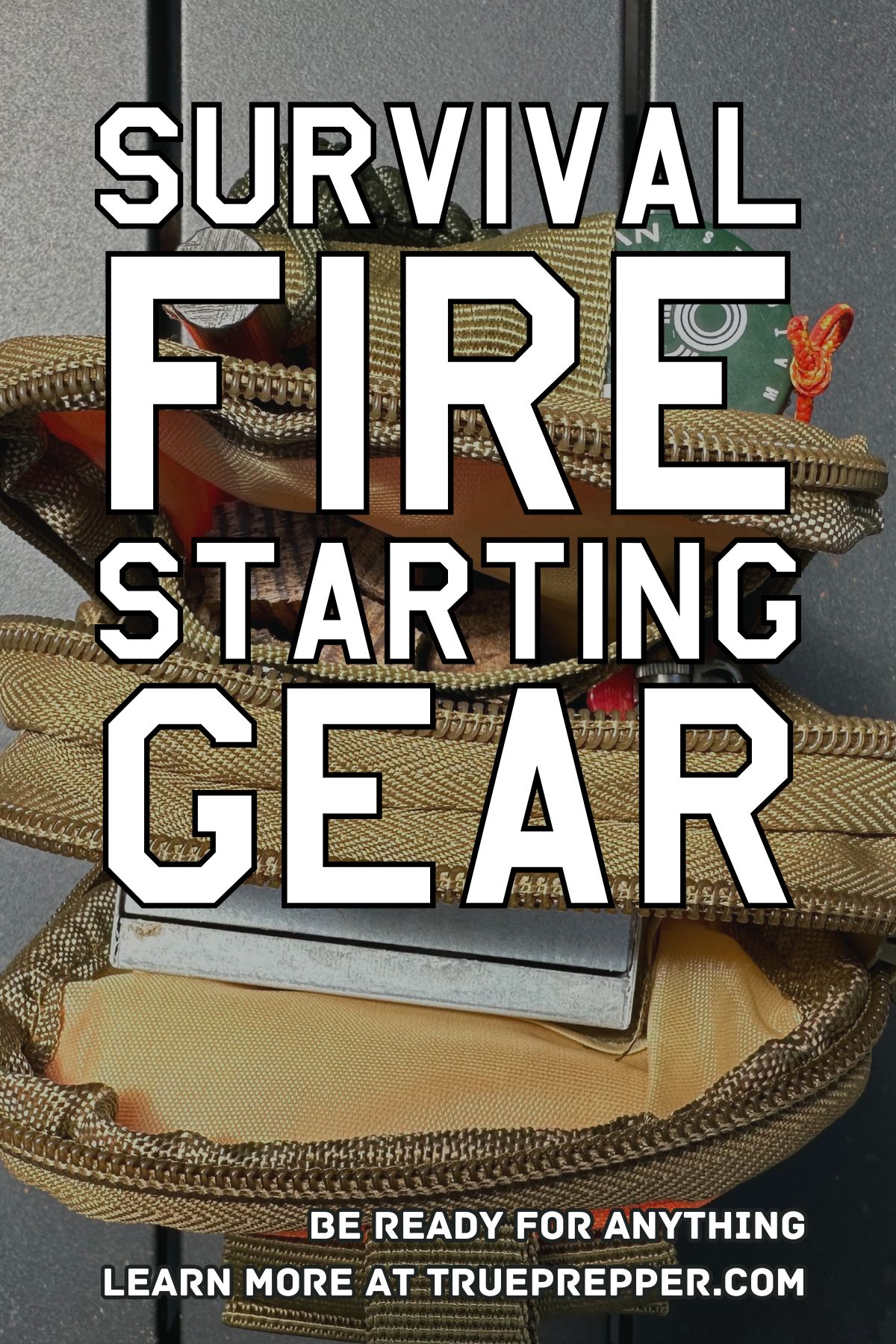Fire is one of the core survival resources that makes many parts of the world remotely habitable. Its incredible versatility lets you cook food, purify water, light areas, warm your body, and commune with others. With a little know-how and the right fire-starting gear, you’ll be able to make fire at will for all of your survival needs.
Despite its survival applications and beauty, it can also be deadly and dangerous in untrained hands. The destructive power of fire shows off its range from firearms to house fires and wildfires.
Regardless, survival requires that you know how to create fire and some basic resources and tips are all you need. This is our cornerstone guide for everything related to making fires for survival and the gear that it takes, whether you’re at home during a disaster or on the road bugging out.
Contents (Jump to a Section)
Bug Out Bag Fire Kit
A survival fire kit, or portable tinder box, is a collection of tools and supplies to help you get a fire started quickly. Bug out bags limit the amount of weight you want to carry, so you don’t carry everything but you do need some backups for an important resource like fire starting.

My fire pouch has a lot in it- most people customize their kits. Sean Gold
Here is the essential fire-starting related gear:
- Lighters – Best survival lighter – We’ve reviewed a few dozen lighters and share the top performers that are reliable and a good value.
- Matches – Best stormproof matches – Regular matchbooks can be cheap and lightweight, but we prefer stormproof matches in our fire kits since they burn no matter what the conditions are (even underwater).
- Ferro rods – Best ferro rods – Ferro rods give you thousands of lights from a simple rod.
- Tinder – Best survival tinder – There are natural and manmade options, but having some in your kit can be a lifesaver.
Optional fire-starting gear:
- Magnifying Glass – Best magnifying glass fire starter – Technically, you can get unlimited lights using the sun and a magnifying glass but practically these can have issues with durability and not working unless conditions are ideal.
- Fire Piston – Best fire piston – These require additional resources, like char cloth, o-rings, and lubrication to work properly.
- Char Cloth – Best char cloth – This useful tinder can also be made at home but it can also get messy.
- Pocket Bellows – Best pocket bellows – A long extending tube to add oxygen flow to the base of a fire.
- Folding Wood Stove – Best survival stove – Mostly used for cooking, wood stoves are still good for containing fires and as a wind guard.
- Emergency Candles – Best emergency candles – carry fire around in candle lanterns or have small tea lights for low-light visibility.

The Fire Triangle
The most fundamental concept of fire is the fire triangle. The shape represents the three essential components to ignite a fire and sustain its combustion:
If any of these components are missing, a fire will not continue to burn. It is a critical part of fire prevention, fire fighting, and survival fire starting.
Fuel
Fuel for a fire is anything combustible. It can be a huge range of things, including logs, paper, gasoline, propane, natural gas, etc. If a fire doesn’t have a consumable element, it is missing fuel and will go out.
Heat
Heat interacts with fuel by adding energy to it until it reaches its temperature ignition point. The ignition point varies for fuel materials (Fahrenheit 451 is a paper example). There are many ways to add heat energy to fuel:
- Existing flame
- Electrical spark
- Friction
- Chemical reaction
Once fuel ignites, it usually can sustain combustion by providing heat itself. Cooling the fuel using water can rapidly lower its temperature, extinguishing the fire.
Oxygen
Oxygen allows the reaction between fuel and heat and is a vital component of the fire triangle. It combines with fuel to release heat and flame. Smothering a fire removes the oxygen available to it, preventing combustion.
Fire Starting Methods
There are many ways to start a fire with a wide range of difficulty and skill needed. Usually, the methods are split between either modern and primitive methods, but we split them between common and unconventional methods.
Common Methods
The three most common fire-starting methods for personal use are:
- Lighters
- Matches
- Ferro rod (or other flint striker)
We recommend these in all of our basic survival kit lists and suggest that you pick two out of three (at least).
The Other Methods
We go over every single method for fire-starting in our guide: 23 Ways to Start a Fire Without Matches or a Lighter.
Finding Fire Sources for Survival
Survival situations can call for resourcefulness, so knowing where to find fire sources could help you if you find yourself in a tight spot. A few commonly overlooked firestarters include:
- Eyeglasses – Use the lenses to focus sunlight to generate enough heat to start a fire.
- Batteries – You can use almost any battery to create a spark or enough heat to start a fire.
- Push buttons – Grill, pilot light, water heater, and gas log push button friction starters are common at homes
Resourcefulness is one of the best survival skills you can have, so consider what fire-starting sources you have around if you lose utility access at home or on the road.
Tinder, Kindling, & Logs
Going back to the fire triangle, we know that we’ll need fuel- and lots of it. While you can burn a lot of things for fuel, some get the job done better and more safely. We focus on the traditional three types of fuel for campfires, which can usually be adapted for fire pits, grills, and other everyday or emergency applications.
Tinder
Tinder is the easily ignited fuel that you first light when you are making a fire.
You can make tinder naturally with dried grass, pine needles, feathered wood, birch bark, shaved fatwood, etc. Natural tinder is usually bundled up into a “bird’s nest” that usually looks like an actual bird’s nest. You don’t want to pack the bird’s nest too tight, because you want space between the tinder pieces for oxygen to flow.
Manufactured tinder can be bought or made. We’ve reviewed the manufactured kind in our best tinder review, but also made our own including:
- Petroleum jelly + cotton balls (store in a bag or tin, it can get messy!)
- Harvested and prepped fatwood tins
- Denim char cloth
Having tinder available to start a fire isn’t just a convenience- in some environments and conditions, it’s necessary to be able to get a fire going.
Kindling
Kindling is the next fuel source which is typically small sticks that bridge the gap between ignited tinder and stubborn logs.
It can help you get fires started quickly. It is easier to collect since you are finding small dry sticks the diameter of your finger that you can break into foot-long lengths. Logs can even be split and splintered into kindling if you need to.
Pine branches work well for kindling and are abundant in most wooded areas.
Depending on your tinder type and your large fuel source (logs), you may be able to skip kindling but it’s still an important bridge step for fires.
Logs
Besides modern large fuel sources, like charcoal and controlled-release gases (LP, NG, etc), the humble wood log is the go-to long-term fuel for survival fires and the only one that doesn’t require significant infrastructure or stored resources.
Knowing how to use a variety of logs, and their specific properties can help you with fire craft.
Hardwoods
Hardwoods are the best for long-lasting fires but are harder to cut, split, and season (dry). The dry time can take years on some logs depending on size, so they can require some planning or additional splitting to speed up seasoning. Dry time is typically inversely proportional to burn time too, so seasoning can be seen as a bit of an investment. Here are some common hardwoods in descending order of dry time:
- Oak – Great for long-lasting fires but can take 1-2 years to dry.
- Hickory – Slightly less dry time than oak.
- Maple – Burns clean with high heat and splits easily.
- Ash – Burns easily even when it is not dried completely (but it also dries fast).
- Birch – Burns hot and fast, dries in less than 2 months. The bark can be used as tinder, which makes this one of my favorite logs for campfires since it’s so versatile.
Softwoods
Evergreen trees can be abundant in some areas and are easy to process into logs. They produce a lot of smoke even when they are dried well, and usually burn quickly.
- Pine – Easy to ignite and it is easy to find downed trees that chop/cut easily.
- Cedar – My favorite softwood has a great smell/noise when burning and is easy to process. (But it does make a lot of smoke).
Building a Fire
The three main types of fire lays for campfires or starting any fire from scratch using wood include the teepee, the lean-to, and the cross-stack. Knowing all three gives you the versatility to address quick starting, getting higher heat versus longer burns, and blocking wind.
The Teepee
A teepee is the first fire lay most people learn, and for good reason. It’s easy to build, lights quickly and burns fast so you can move on to something else. It also is great for lighting kindling, so it is usually used for other fire lays to at least get them started.
How to build a teepee fire lay:
- Put the tinder bundle on the ground or in the fire pit.
- Build a teepee cone around the tinder, leaving plenty of gaps for air and a door to access the tinder.
- Add larger kindling around the teepee structure until you have placed the firewood you plan to use.
- Light the tinder.
If the teepee collapses, you can still add kindling and logs on top of the collapsed structure as long as you don’t smother the fire.
The Cross-Stack
The cross-stack, or variations like the log cabin are ideal for long-burning fires. They are great at burning for a long time and in a predictable way. Each solid layer that you build under the starting structure can typically be expected to burn for 30 minutes. This makes the cross-stack ideal for camping and generating warmth, since you can control burn time with the build.
You also don’t need to reduce logs quite as much with cross-stack- logs that are 5-8″ in diameter just need to be split down the middle.
How to build a cross-stack fire lay:
- Stack halved logs in alternating layers with larger halves on the bottom to create a foundation.
- Place tinder bundle on top of stacked logs.
- Make a small teepee around the tinder bundle with small kindling.
- Stack larger kindling around tinder bundle and teepee in alternating layers making a log cabin.
- Light the tinder.
Once the top layer log cabin lights the cross-stack foundation, you can add fuel to the fire if needed as long as you don’t smother it all at once.
The Lean-To
A lean-to is a great option for open areas and windy conditions since you set up the large logs as a windscreen.
How to build a lean-to fire lay:
- Place the tinder bundle on the ground or in a fire pit.
- Upwind of the tinder, either stack logs or stick large kindling into the ground slightly angled over the tinder as a wind barrier.
- Place the rest of the kindling at an angle over the tinder propped up by the barrier logs/kindling.
- Light the tinder.
Keep the wind barrier intact as much as possible as the fire burns by adding to it as needed.
How to Start a Campfire
Campfires are easy to start and manage safely with some hands-on experience. The basic steps to start a campfire are:
- Gather fuel materials (tinder, kindling, firewood).
- Build your campfire (teepee, log cabin).
- Light the tinder.
- Keep the fire going using the fire triangle principles.
- Extinguish the campfire safely.
We go over all of the steps in more detail in our guide: How to Start a Campfire: A Basic Survival Skill
Fire Safety
There’s no doubt that fires are dangerous. House fires destroy $15 billion worth of property and kill thousands in the US every year. Stack wildfire destruction on top of that and the impact is immeasurable.
Fire safety should be paramount whenever you are around fire tools. Don’t just be responsible for yourself- prevent others from creating dangerous situations for themselves and their communities.
Fire Rules and Regulations
If you’re not in a dire emergency, you’ll need to follow some basic rules. Sometimes fire bans can go into effect, meaning that you simply shouldn’t be starting fires. This can be due to droughts, high winds, or other factors that increase fire risk.
Next, you should be following the principles of Leave No Trace. This means that you should only make fires as big as you need them to be, use fire rings as much as possible, and completely extinguish ashes before scattering them.
Personal Safety
Besides having a fire extinguisher or plenty of water on hand to effectively control a fire, you’ll also want to be mindful of the clothes you are wearing. Synthetics can melt easily and baggy clothing can accidently droop into the flames to catch fire. Wearing non-baggy survival clothing is ideal.
Survival Fire Hacks
There are a few distress signals and unconventional tips that can help you out in a bind if you need them.
Fire Distress Signals
Fire smoke signaling is tougher to control than you may think, so the best option for daytime signaling is to just generate as much smoke as you can. To do this, you can put green foilage in the fire for thick white smoke. If you have access to a tire, that can make dense black smoke in dire emergencies.
At night smoke is much harder to see, so creating three fires in a triangle is the universal distress signal. This isn’t as helpful for people connecting on the ground, but is what air search and rescue would be on the lookout for.
Survival Hacks
Survival hacks can come in handy when you are short on resources or don’t have all of your fire-starting gear.
While we already went over a wide range of odd ways to start fires, there are a few more fire survival tricks you can put up your sleeve. These are all focused on ways to keep fire around with makeshift candles.
One interesting hack is that a crayon can hold a flame for 30 minutes:
Another common hack is using oil from canned goods to make a makeshift candle:
Sources and References
- Hall, S. (2023). Fire loss in the United States. NFPA Research. (Source)
- Leave No Trace. (2024). Principle 5: Minimize Campfire Impacts. (Source)
- Tilton, B. (2005). The Complete Book of Fire. Building Campfires for Warmth, Light, Cooking, and Survival. Menasha Ridge Press. (Source)
The Final Word
Whether you are making a spark to start your emergency stove or creating a campfire to boil water, fire is an important preparedness tool. With practice, anyone can be competent in making fires in a wide range of situations with many types of resources.
Here are some other guides our subscribers have found useful:
Keep exploring, stay prepared, and be safe.
You’ve Been Missing Out
Join the 2+ million preppers that rely on our prepping advice by subscribing to TruePrepper.
- Practical guides and tips
- Useful survival giveaways
- Free, forever
- < 0.4% of people unsubscribe
Thanks for subscribing, reading, and welcome to the club.

The post Survival Fire Starting Gear appeared first on TruePrepper.
https://trueprepper.com/survival-fire-starting-gear/
 CampingSurvivalistHuntingFishingExploringHikingPrivacy PolicyTerms And Conditions
CampingSurvivalistHuntingFishingExploringHikingPrivacy PolicyTerms And Conditions
